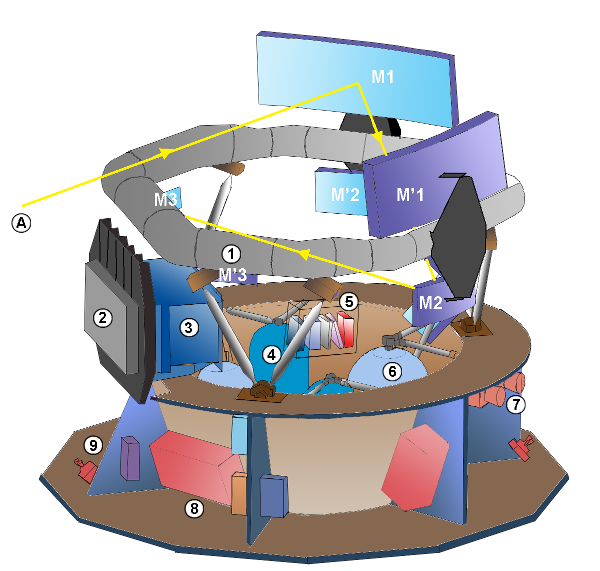
Image courtesy of Wikipedia
 Copyright © Michael Richmond.
This work is licensed under a Creative Commons License.
Copyright © Michael Richmond.
This work is licensed under a Creative Commons License.
A good overview of the Gaia mission and its ability to detect planets around other stars is given in
Astrometric exoplanet detection with Gaia (Perryman et al., ApJ 797, 14 (2014))
Gaia is a rather unusual "telescope," since it has been specially designed for astrometric observations. It resembles the Hipparcos satellite in many ways. The basic structure is built around two triple-mirror telescopes which point at regions in the sky separated by an angle of about 106.5 degrees.

Image courtesy of
Wikipedia
Light from the two telescopes is combined so that it falls upon the focal plane simultaneously. The telescope rotates with a period of six hours, causing stars to sweep across this focal plane in about 60 seconds. Objects in both directions are detected and measured together.
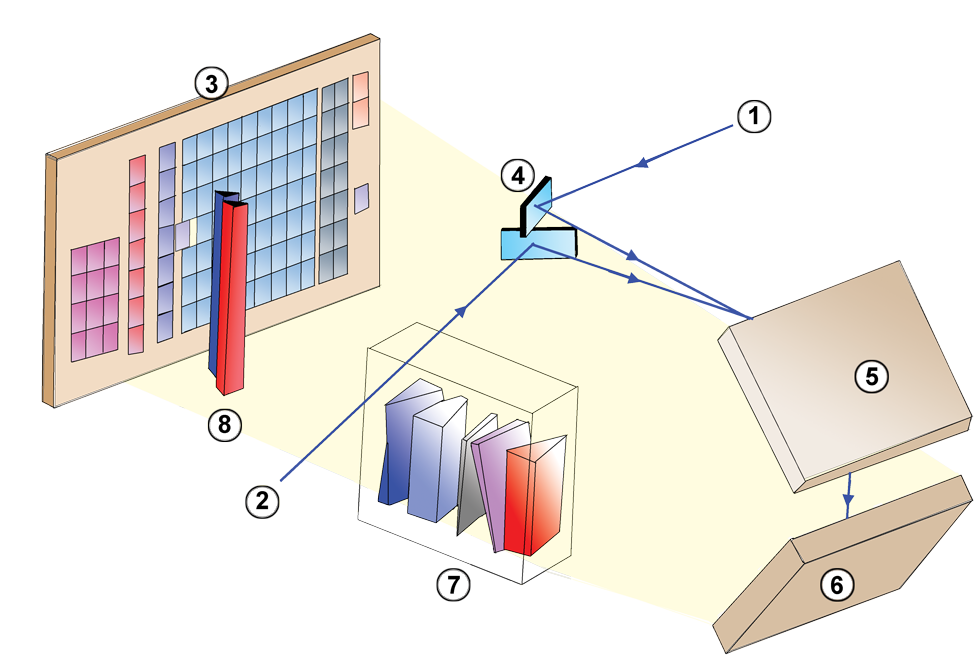
Image courtesy of
Wikipedia

Figure 1 from
Lindegren et al. 2016. Note that this figure
is rotated by 180 degrees relative to previous schematic.
The original caption follows.
Layout of the CCDs in Gaia's focal plane. Star images move from left to right in the diagram. As the images enter the field of view, they are detected by the sky mapper (SM) CCDs and astrometrically observed by the 62 CCDs in the astrometric field (AF). Basic-angle variations are interferometrically measured using the basic angle monitor (BAM) CCD in row 1 (bottom row in figure). The BAM CCD in row 2 is available for redundancy. Other CCDs are used for the red and blue photometers (BP, RP), radial velocity spectrometer (RVS), and wave- front sensors (WFS). The orientation of the field angles η (along-scan, AL) and ζ (across-scan, AC) is shown at bottom right. The actual origin (η, ζ) = (0, 0) is indicated by the numbered yellow circles 1 (for the preceding field of view) and 2 (for the following field of view).
The telescope slowly precesses, so that its spin sweeps out new areas in the sky over time. A typical star will be measured about 70 times over the course of the primary mission (2014 - 2019); that's about 14 measurements per year, though not all equally spaced.
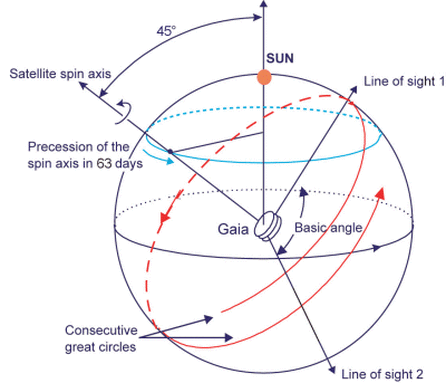
Image courtesy of
Space Flight 101
Click on the picture below to see a video of Gaia's observing procedure .
As the spacecraft precesses, the "partners" of each star will gradually change. Eventually, the spacecraft will have many millions (billions?) of measurements of the relative positions of millions of stars. Scientists can then use a honking-big linear algebra procedure to solve simultaneously for the positions and motions of each star.
How precise are the measurements made by Gaia? A recent paper by de Bruijne, Rygl and Antoja provides some predictions based on the earliest in-flight tests.
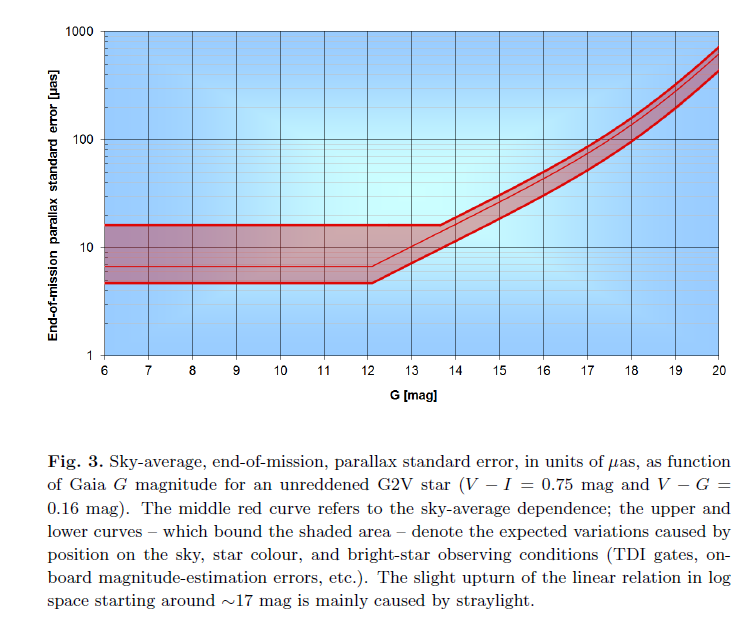
Fig 3 taken from
de Bruijne, Rygl and Antoja (2015)
Remember the table shown in the previous lecture, which displayed the limits for detecting astrometrically the presence of a Jupiter-like planet orbiting a Sun-like star?
| dist to system | R = 0.1 AU | R = 1 AU | R = 10 AU | R = 100 AU |
| 1 pc | 0.1 mas | 1 mas | 10 mas | 100 mas |
| 10 pc | 0.01 mas | 0.1 mas | 1 mas | 10 mas |
| 100 pc | 0.001 mas | 0.01 mas | 0.1 mas | 1 mas |
If those predictions are accurate, then the table of "which stars will show measureable astrometric motions?" will look like this:
| dist to system | R = 0.1 AU | R = 1 AU | R = 10 AU | R = 100 AU |
| 1 pc | 0.1 mas | 1 mas | 10 mas | 100 mas |
| 10 pc | 0.01 mas | 0.1 mas | 1 mas | 10 mas |
| 100 pc | 0.001 mas | 0.01 mas | 0.1 mas | 1 mas |
But the very first Gaia data has been released! As described in Lindegren et al. 2016, the Gaia Data Release 1 consists of a limited set of measured properties for a very limited set of bright stars. Later releases will contain (much) better data for (many) more stars.
Let's make a very quick comparison: let's compare the standard uncertainty in the measurement of parallax (often described with the Greek letter ϖ) in the Data Release 1 compare to the predicted standard uncertainty in the FINAL dataset.
Q: What is the prediction for standard uncertainty
in the parallax of a bright star?
Look in Figure 3 from de Bruijne et al. (2015) above.
Q: What is the actual standard uncertainty in the
parallax for a bright star in DR1?
Look in Table 1 or Figure 7 of Lindegren et al. 2016
Q: How will the final values reach the smaller uncertainty?
Of course, Gaia will do much, much more than discover exoplanets. Its main goal is to measure stellar distances and motions, and so improve our knowledge of galactic structure and populations. Any exoplanet discoveries will be icing on the cake.
Q: Suppose that Gaia can measure the parallax of stars with
an uncertainty of 10 micro-arcseconds.
How far out into space can we trust the measurements
of stellar distances?
You might think that the answer is simply "maximum good distance is the reciprocal of uncertainty in parallax", which would yield a range of about 42,000 pc; but that ignores an important bias in parallax measurements.
In any case, Gaia will greatly increase our knowledge of the stellar neighborhood. It will produce a catalog of roughly 100 million stars with distances good to about 10 percent. The Hipparcos catalog contains only 0.12 million entries, of which only about 0.04 million satisfy the Lutz-Kelker criterion.
Another recent paper provides some numbers on Gaia's photometric precision:
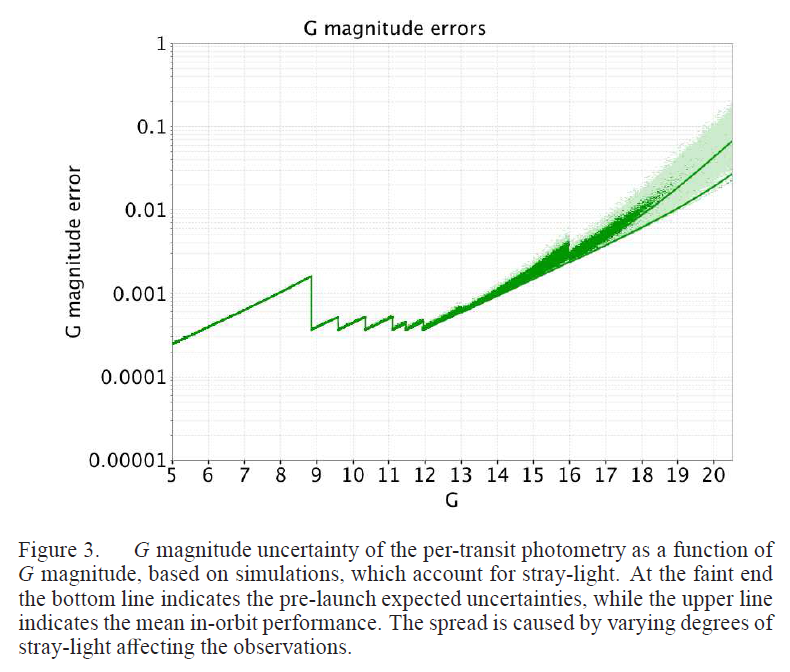
Figure 3 taken from
Eyer et al., 2015
Let's look at the timeline for Gaia operations and data releases -- a timeline written in 2015, mind you.
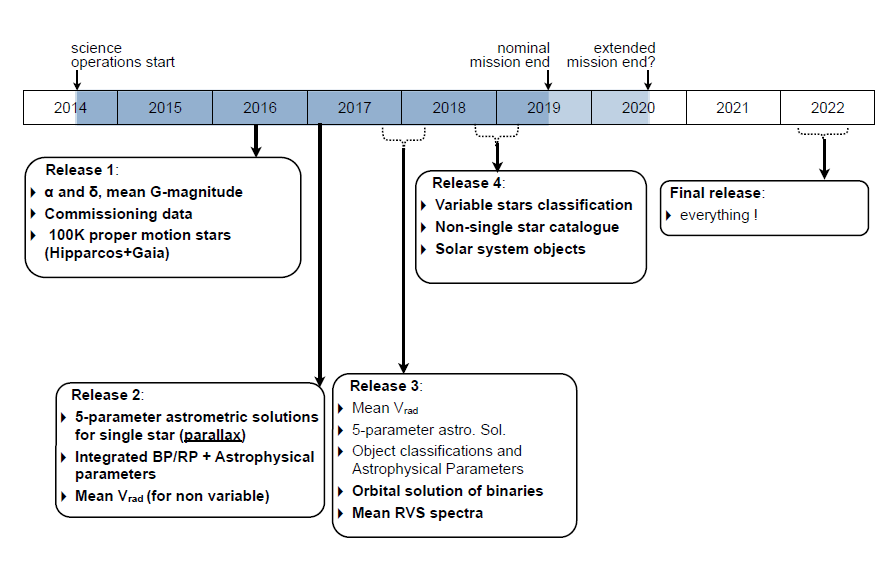
Figure 8 taken from
Eyer et al., 2015
Q: When will Gaia release a catalog which includes exoplanets?
Alas, in the years which have passed since that publication, the Gaia data reductions have gone more slowly than expected. If one visits the Gaia Data Release Scenario page, one will find (as of Feb 25, 2018) the following schedule:
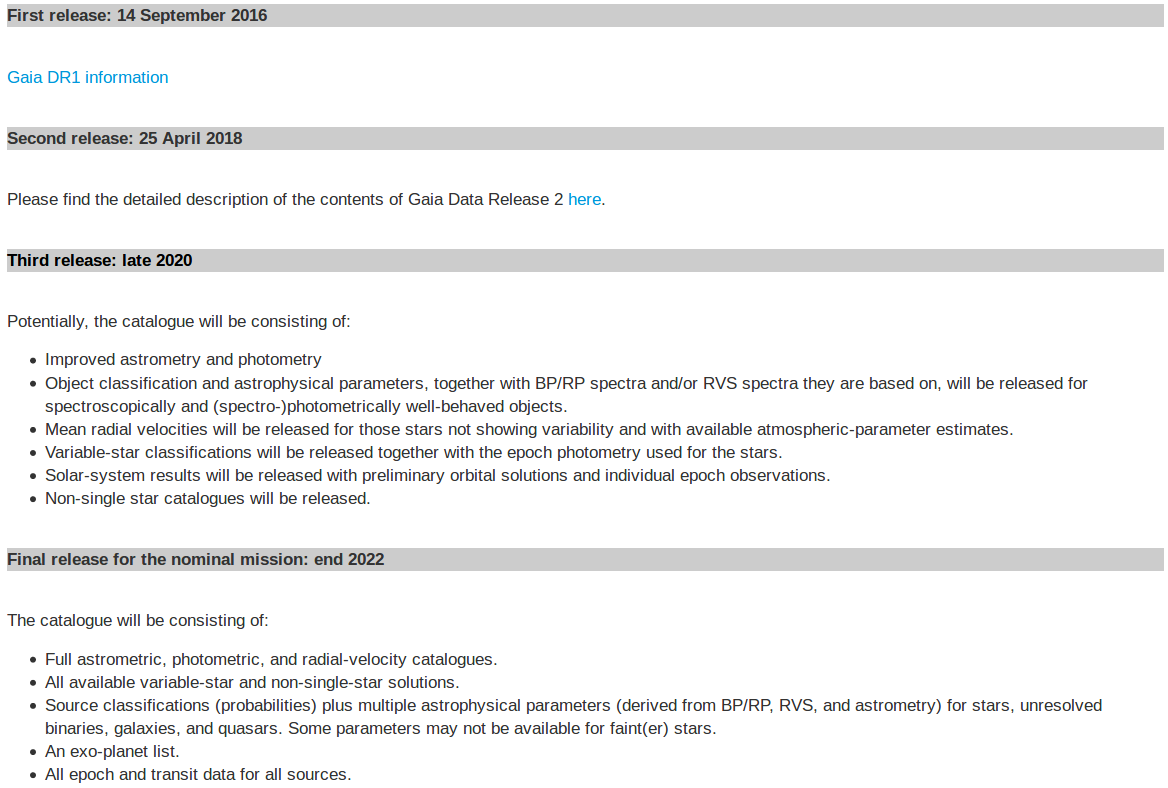
Table scraped from
Gaia Data Release Scenario page
on Feb 25, 2018.
Q: What sort of planets will Gaia be most likely to detect?
What sort of properties are the planets detected by Gaia likely to have? I've added shaded regions to these diagrams to indicate very roughly the objects to which Gaia should be most sensitive.
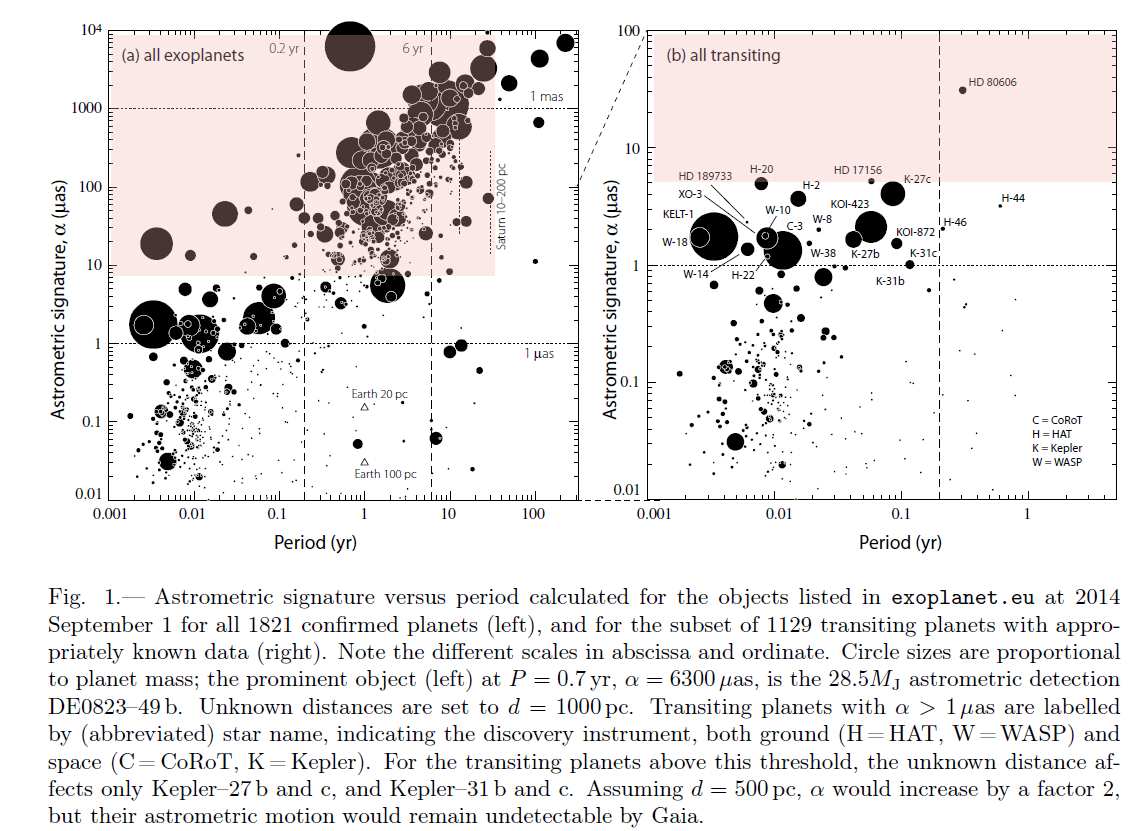
Image modified from Fig 1 of
Perryman et al., 2015
How can one access the data measured by Gaia? One way is to use the catalog interface provided by the wonderful Vizier service (thanks to the CDS) . For Gaia in particular, we might choose the Vizier interface to the Gaia TGAS catalog.
However, the full Gaia database(s) are so large tha the Vizier service may not contain all their information. In addition, one may wish to ask complicated questions, such as "which stars between magnitudes 11 and 13, lying within 5 degrees of the Orion Nebula, have parallaxes consistent with the Orion Molecular Cloud?" In such cases, one might do better by visiting the Gaia Database itself ....
Go to the Gaia Archive page

and click on the "Search" icon.
Now, from this search page, one can make a simple search based on name or position, or even add a few more conditions ...
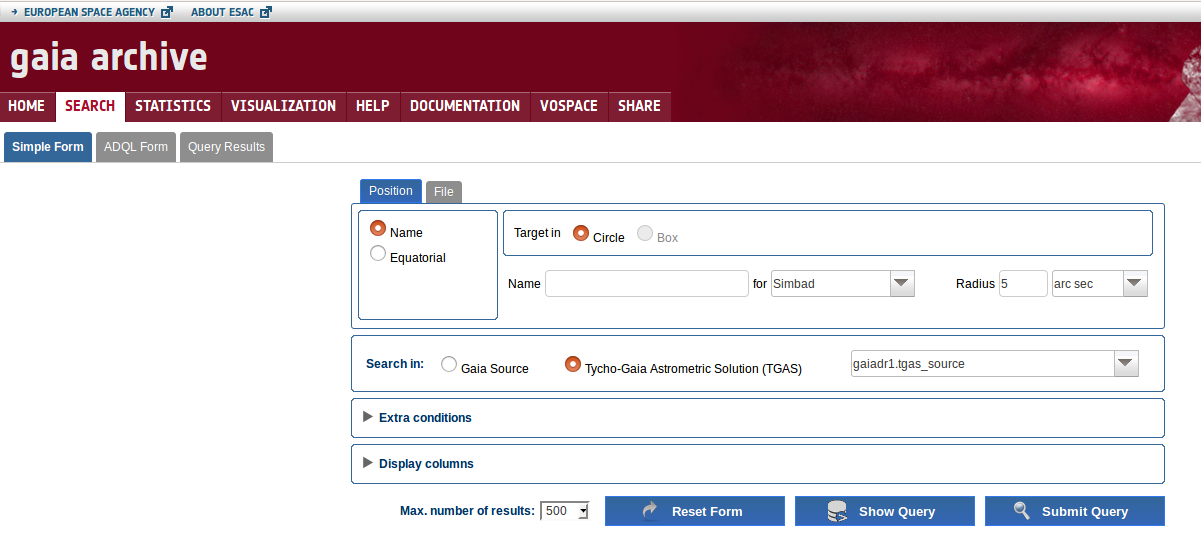
... but in order to make more complicated queries, one should use the ADQL Form: This provides a full SQL-like query language with which one can access the database.
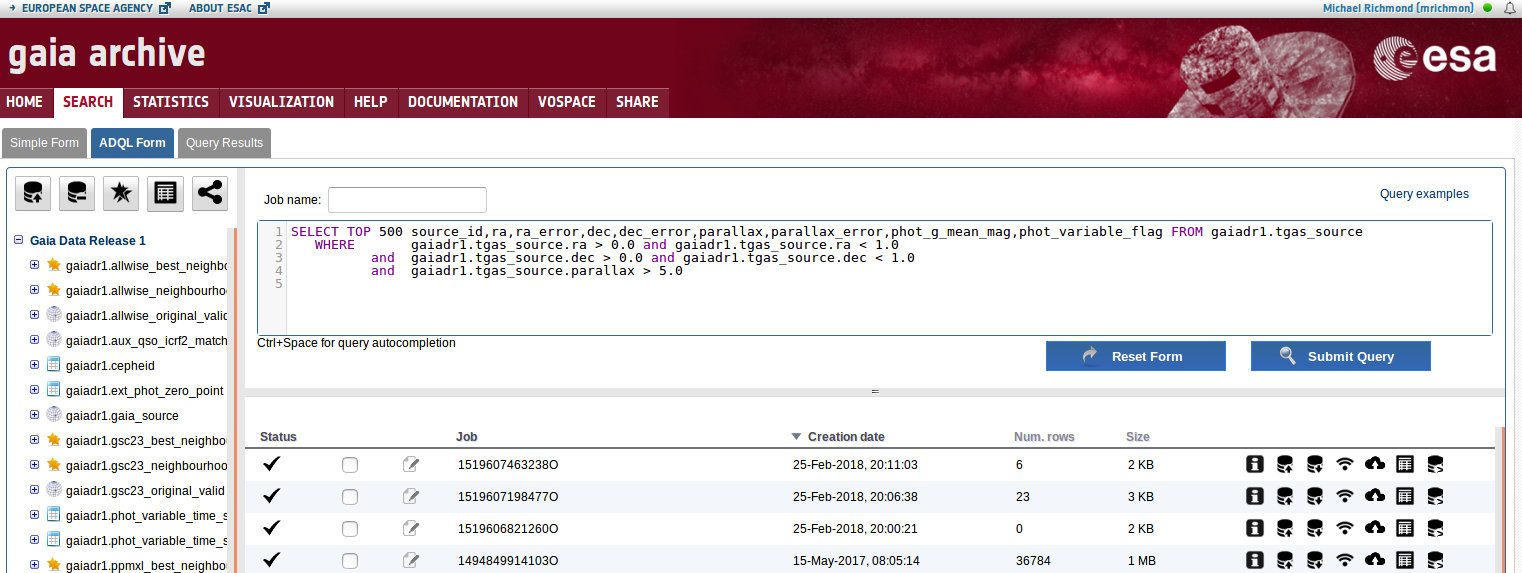
In the example above, I asked for all entries in the Tycho-Gaia Astrometric Solution (TGAS) catalog which satisfy the following conditions:
There are 6 objects in the TGAS which satisfy all these conditions.
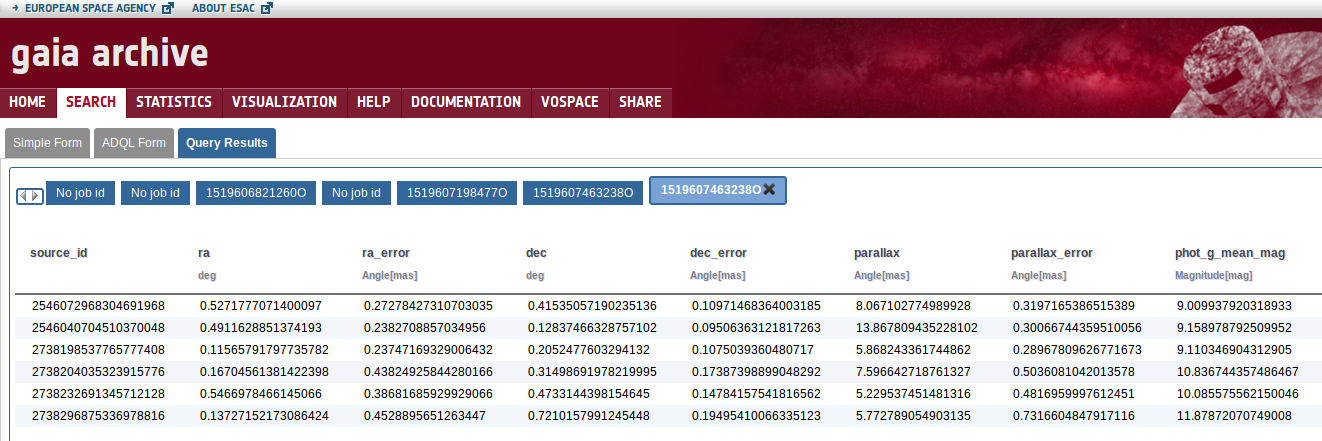
Q: Estimate the number of stars in the TGAS which have
parallax values greater than 5.0 milliarcsec.
There's other science in Gaia, too. Asteroids, for example. Below is a figure showing the statistics of asteroids detected by Gaia during Jan - Mar, 2015.
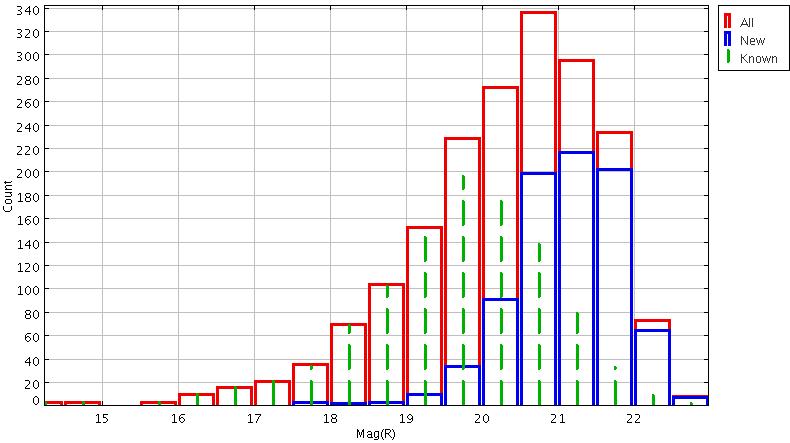
Fig 4 taken from
The GBOT asteroid finding programme
I haven't even mentioned Gaia's spectroscopic measurements, have I? Too little time!
 Copyright © Michael Richmond.
This work is licensed under a Creative Commons License.
Copyright © Michael Richmond.
This work is licensed under a Creative Commons License.